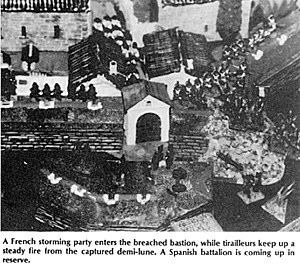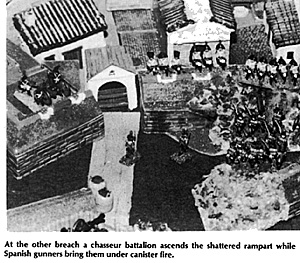 "Most wargamers ignore sieges for the very good reason that they make
extremely boring games." So wrote Bruce Quarrie in his "Napoleon's Campaigns
in Miniature", and in his assessment there is some truth. The average siege
wargame is simply a conventional field battle with lot of earth and stone
obstacles holding up movement. The problem here is that the siege assault is
no more like an open battle than a brigade level action is like the clash of two
army corps; by trying to lump different types of events together we get
clumsy, inappropriate games that do scant justice to their subject.
"Most wargamers ignore sieges for the very good reason that they make
extremely boring games." So wrote Bruce Quarrie in his "Napoleon's Campaigns
in Miniature", and in his assessment there is some truth. The average siege
wargame is simply a conventional field battle with lot of earth and stone
obstacles holding up movement. The problem here is that the siege assault is
no more like an open battle than a brigade level action is like the clash of two
army corps; by trying to lump different types of events together we get
clumsy, inappropriate games that do scant justice to their subject.
A French storming party enters the breached bastion, while firailleurs keep up a steady fire from the captured demi-lune. A Spanish battalion is coming up in reserve.
FORLORN HOPE is an attempt to approach the assault of a fortress on its own terms. This is not a game about the entire march of a siege, making reference to Armies of Observation and questions of logistics; these are matters for the GOC and staff. Nor is it a game of tracing parallels, placing mines or breaching bastions; those are the concerns of the gunners and engineers. (Both of these topics would make excellent games of their own.)
About Infantry
This is a game about the infantry; the officer and soldier engaged in the vicious, primeval business of undertaking storms and sorties. This is not a matter of neat linear formations and orderly volleys; few commanders have more than one or two options at any given time, and maneuver is stymied by the obstructions of static positions. A soldier in an assault is likely to be involved in a confused, desperate struggle in which he is placed under the most daunting psychological stress.
In recognising the nature of this form of warfare we need to abandon accepted game concepts that have no validity. There will be no neatly formed lines and unit morale tests, nor written orders; there will be none of those measured moves that get you three-quarters the way up a slope. There is no set time scale. Instead we require a fluid, fast-paced game involving a bit of luck, a lot of nerve, and handfulls of dice rolled like volleys in the half-light. Enough of the chess-player's wargame! Let's sweat a little.
 At the other breach a chasseur battalion ascends the shattered rampart
while Spanish gunners bring them under canister fire.
At the other breach a chasseur battalion ascends the shattered rampart
while Spanish gunners bring them under canister fire.
FORLORN HOPE began life as a few basic rules for a very impromptu refight of the Alamo in 1981. After a few turns of play using a perfectly acceptable set of Napoleonic Divisional rules it became clear that they were simply "not right" for this kind of action; therefore, after demoting the rulebook to serve as a template for the explosion of the magazine, we made up more appropriate mechanisms as we went along. Over several months a system deriving both from the simplicity of the Featherstone tradition and the radical exploration of Wargame Developments was beaten into some kind of shape; FORLORN HOPE was well received at Wargame Developments Pendrell Hall conference in the England Midlands in 1983, and was published in Nugget 20, April 1984. My thanks go to Arthur Harman, editor of that august journal, for encouraging the spread of W.D. concepts in wargaming.
Gentlemen, it is time to remove packs and leather stocks, take a last swallow of grog, and once more into the breach.
More Forlorn Hope
Back to Table of Contents -- Courier Vol. VII #6
To Courier List of Issues
To MagWeb Master Magazine List
© Copyright 1987 by The Courier Publishing Company.
This article appears in MagWeb (Magazine Web) on the Internet World Wide Web.
Other military history articles and gaming articles are available at http://www.magweb.com